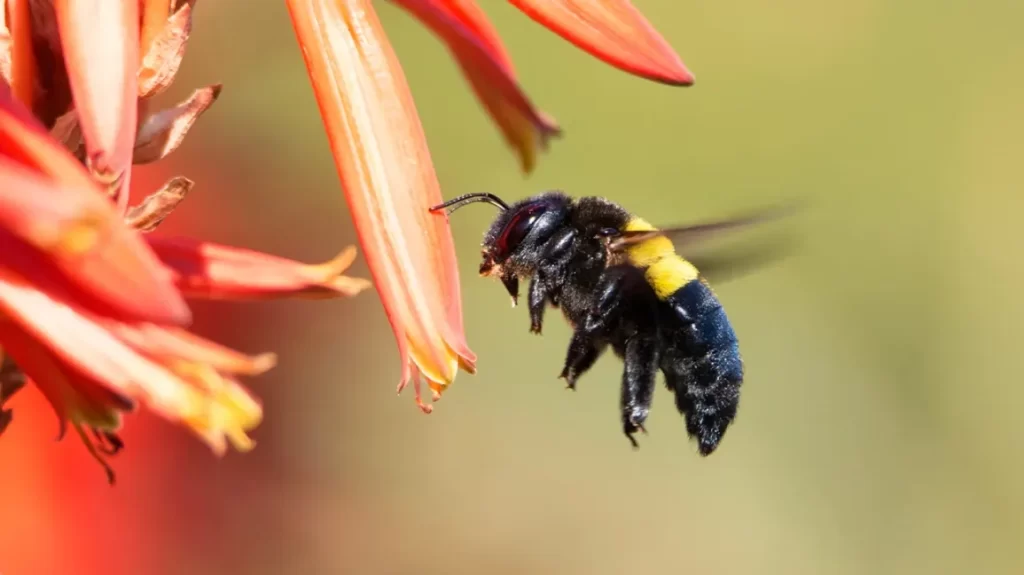There are more than 22,000 species of bees, and they come in different shapes and sizes, each with unique characteristics. The strangest one is the carpenter bee.
Bees are an essential part of our ecosystem and are known for some of the delicious honey they produce. Do carpenter bees have this extraordinary ability – do they make honey?
What is a carpenter bee?
Carpenter bees are often confused with bumblebees because they look very similar. However, they can be distinguished by a certain characteristic – a marker. Bumblebees have hairy abdomens with the familiar black and yellow stripes. Carpenter bees have a hairless, glossy black body.
Carpenter bees are not like honeybees, which build and live in combs, or bumblebees, which nest in holes in the ground. They have a unique ability to burrow into wood.

They use this skill when nesting, creating a system of tunnels in the wood of their choice. The old nest is often reused and rebuilt by each visitor. This network can become so complex and extensive that it can compromise the structural integrity of the wood itself.
Their “craft” has led some to condemn them as harmful pests. Carpenter bees prefer softwood trees like pine, cedar, or spruce, which include wood — potentially causing structural damage to any wooden building.
Carpenter Bees and the Environment
Despite many attempts to eradicate them as pests, the role of carpenter bees benefits the environment in ways we cannot ignore. Like other bees, they feed on nectar and pollen. So they visit flowers in search of food. Because of their large bodies, carpenter bees are very efficient pollinators, providing a huge boost to the ecosystem.
They also have the ability to vibrate flight muscles at specific frequencies. This is called buzzing pollination — a skill that bees don’t have. The vibration causes the pollen to separate from the flower.
As a result, carpenter bees have proven to be less troublesome. In Australia, their tomato yield increased by 10% due to pollination performance. Eggplants, blueberries and lingonberries also benefit from this method of pollination – they produce larger fruits in abundance.
Carpenter bee and honey
Not all bees produce honey. Their order Hymenoptera is divided into seven families. Only one of them is known for honey production – the Apisidae.
How do bees make honey?
The production of honey is a laborious process that few species can accomplish. The process involves converting nectar into honey. This is achieved through reflux, enzymatic activity and water evaporation.
Various bees must work together as a colony to accomplish this task. Therefore, only truly social bee species (meaning “truly social”) can produce honey. The process also requires the presence of a queen and a large group of workers – a task that requires coordination and collaboration.
Bees collect nectar from flowers and ingest it into their honey stomach. This is where salivary enzymes and proteins from the hypo-pharyngeal glands of honeybees act on them, breaking down the nectar sugars.
When the bees return to the hive, they regurgitate the nectar and pass it on to other bees, which will ingest and regurgitate it. They pass the nectar from one bee to another until the best quality is achieved. Only then will the honey be introduced into the honeycomb cells.
To prevent fermentation, they don’t seal these cells until the water content is reduced. The bees in the hive will beat their wings in sync together to circulate the air and evaporate the water. After the task is complete, the moisture content should drop to around 18%.
Do carpenter bees make honey?
Although there are over 730 species of carpenter bees, none of them produce honey. The reason is that they do not belong to the honey producing family – they are classified as Xylocopinae.
Carpenter bees are solitary bees. Male and female mates mate and raise young – they are close to each other in burrows.
Solitary bees are known for their aggressive foraging behavior, which makes them ideal for pollination. Unfortunately, the amount of effort required to make honey is beyond their capabilities.
Bees are believed to produce only 1/12 teaspoon of honey in their lifetime. Social connections are important for collecting enough nectar and producing honey. This trait does not exist in carpenter bees.
The division of labor is essential for honey production.
In summary
Due to lack of knowledge, carpenter bees are misunderstood as nuisance pests. Their inability to produce honey and unconventional nesting habits lead people to believe they were useless. This is not right – they are very important to the ecosystem and not just for the dues they pay.

